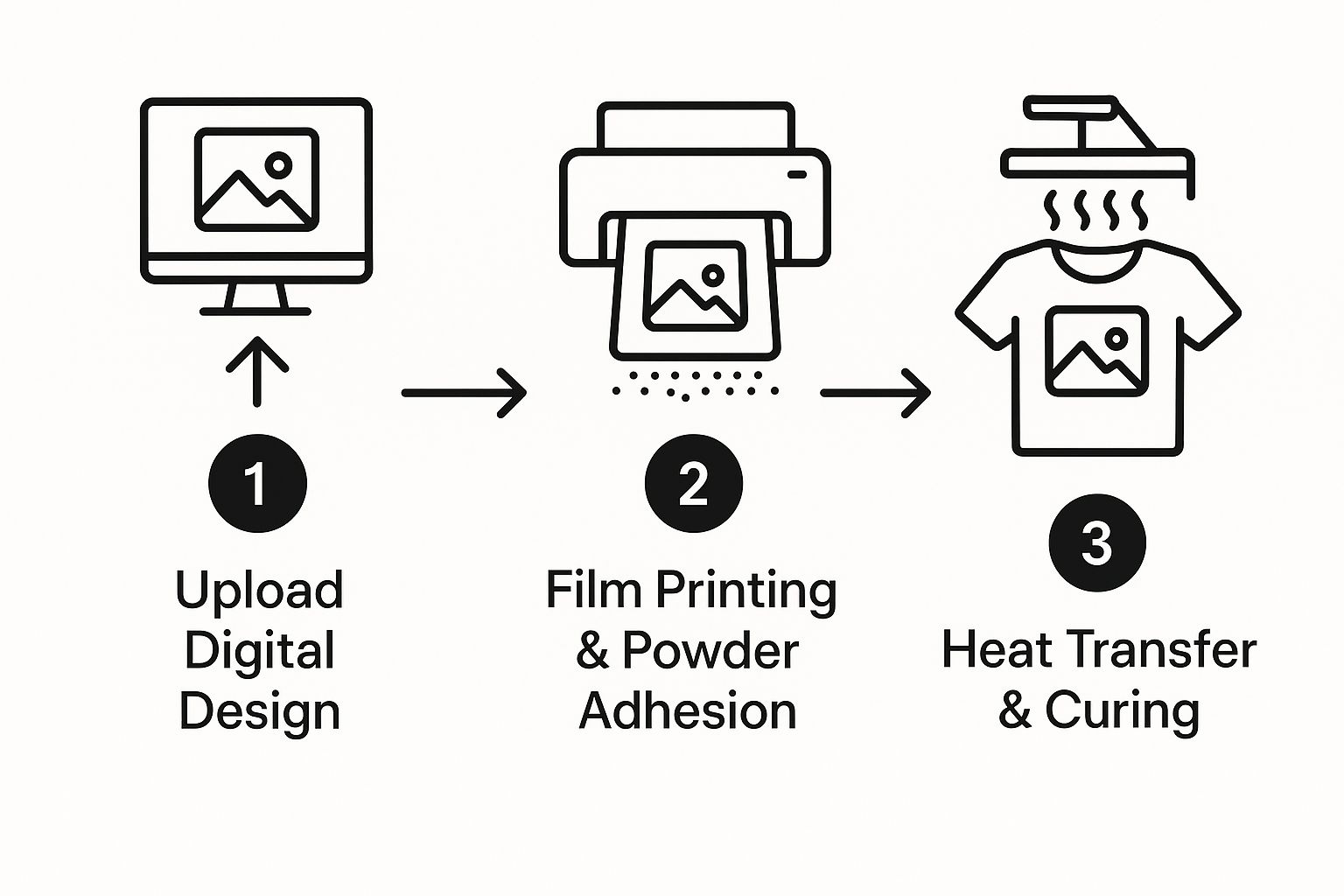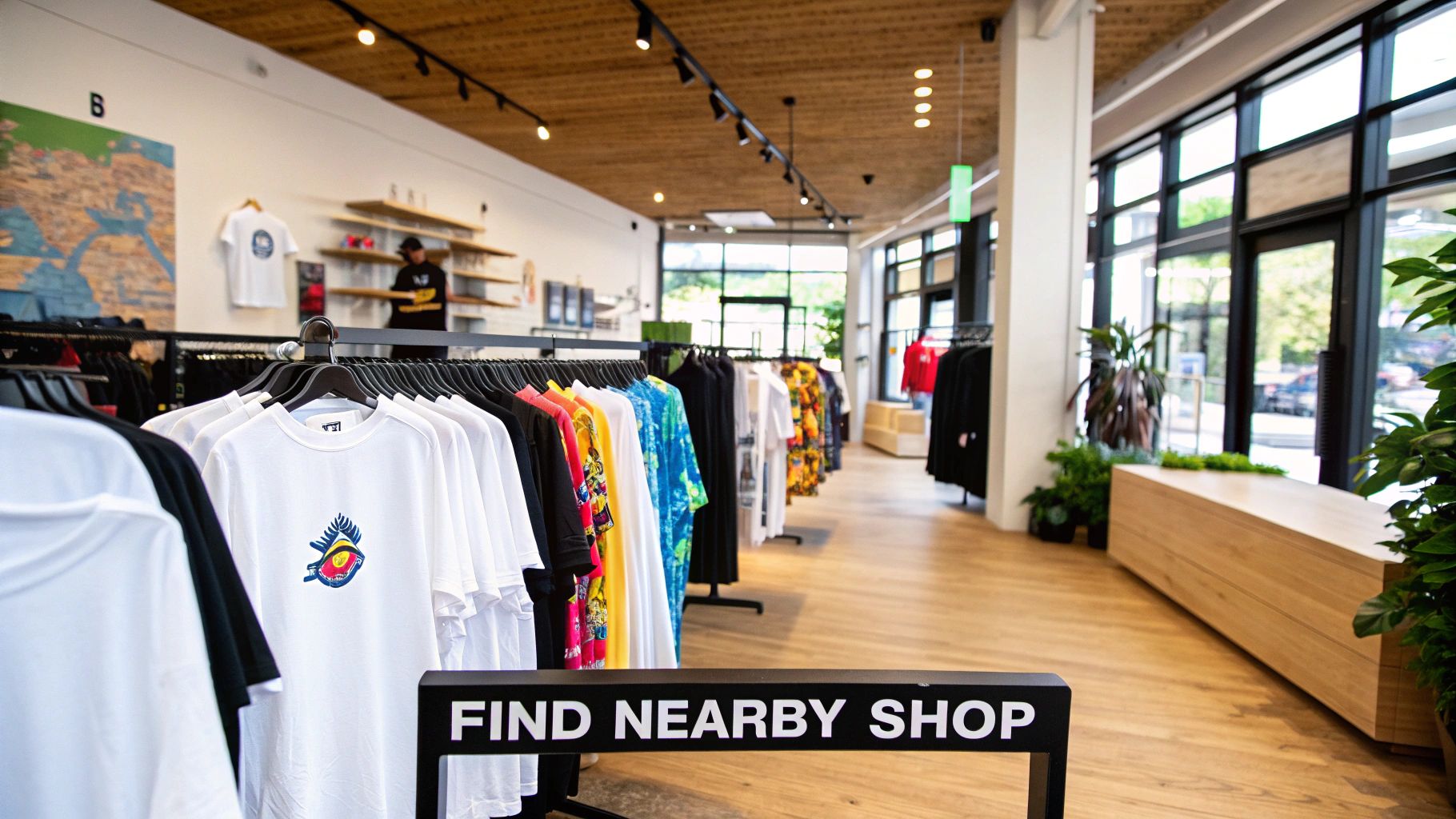
Finding DTF Printing Near Me in the UK
Share
Struggling with long shipping times and disappointing print quality? If you've ever typed “DTF printing near me” into a search bar, you're on the right track. Connecting with a local expert means faster turnarounds, lower costs, and—best of all—the chance to see and feel samples before you commit to a big order. It’s a smarter way to get professional-grade custom apparel with a much-needed personal touch.
Why Choose a Local DTF Printing Service?
The world of custom apparel is crowded, but Direct-to-Film (DTF) printing has quickly become a game-changer. It's a brilliant method for creating incredibly detailed, vibrant, and durable designs that work on just about any fabric you can think of—cotton, polyester, blends, you name it. Unlike old-school screen printing, DTF doesn't need complicated setups, making it perfect for smaller batches and designs with lots of different colours.
But the real magic happens when you take this technology and find a provider in your own community. Working with a local printer unlocks a whole host of practical advantages that you just can't get from a faceless online-only service.
The Tangible Benefits of Going Local
One of the first things you'll notice is the end of frustrating shipping delays and surprise costs. Forget waiting days (or weeks!) for an order to travel across the country. You can often just pop over and collect it yourself or get it delivered locally in a flash. For anyone with a tight deadline for an event or a last-minute merch idea, this is a massive win.
When you partner with a local DTF printer, you're not just another order number. You get direct access to their expertise. You can chat about your project face-to-face, hold physical samples to check the colour and feel, and build a real relationship that guarantees you get consistent, quality results every single time.
This hands-on approach is perfect for the UK's booming personalised apparel scene, which is being driven by creative small businesses and independent brands. DTF is incredibly efficient for short runs, which also fits perfectly with the fashion industry's growing focus on sustainability and reducing waste.
Here’s a quick rundown of what you gain by keeping it local:
- Faster Turnaround Times: Get your prints in your hands in hours or a couple of days, not weeks.
- Reduced Costs: Kiss those expensive shipping and handling fees goodbye.
- Quality Assurance: Actually inspect a physical sample before you green-light the full run.
- Direct Communication: Get expert advice and sort out any issues quickly, often in person.
Getting a feel for the wider world of printing can also help you see why DTF is such a great option. For a solid comparison of how digital methods stack up, this guide on digital printing vs offset offers some great background. And for more specific tips, don't miss our guide on custom T-shirt printing in London.
How to Find the Best DTF Printers in Your Area
Finding a solid, local partner for your DTF printing isn't as simple as a quick Google search. To really get to the good stuff, you need to think like a customer and get specific with how you look. Forget just typing "dtf printing near me"—that’s a recipe for getting a list of massive, impersonal online suppliers.
You need to be more tactical. Try searching for exactly what you need, like "DTF transfers for hoodies Birmingham" or "custom workwear printing SW1A". This small change makes a huge difference. It weeds out the national chains and pushes the local, specialised workshops right to the top of your search results.
Go Beyond Standard Searches
A targeted search is your starting point, but don't stop there. Google Maps is a brilliant tool for this. You can visually pinpoint print shops in your area by searching for broader terms like "garment printer" or "t-shirt printing," then just hop onto their websites or give them a quick call to see if they do DTF.
Social media, especially Instagram, is another goldmine. It's a visual platform, so it’s perfect for printers to show off what they can do. Search for local hashtags like #DTFPrintingManchester or #LondonPrinters. This is a great way to see the real-world quality of their work and find businesses that are actively printing for customers like you.
The skills you use to find a great DTF printer are pretty universal. In fact, the advice in a guide on how to find expert sign writing near me shares a lot of the same core principles. We’ve also found that many of the tips for finding custom t-shirt printers are directly applicable here too.
To give you a better idea of what to look for, here are some search queries that will get you more targeted results.
Effective Search Queries for Local DTF Providers
| Search Intent | Example Search Query |
|---|---|
| Specific Product & Location | "Custom DTF transfers for hats Bristol" |
| Material-Specific Need | "DTF printing for polyester sportswear Leeds" |
| Urgent Requirement | "Same day DTF transfers near me" |
| Bulk Order Inquiry | "Wholesale DTF gang sheets Manchester" |
| Business-Focused Search | "DTF printing for small business London" |
Thinking this way helps you cut through the noise and connect directly with printers who can actually handle your job.
Below is a quick visual breakdown of the typical DTF printing process you'll find at a local shop.

This shows exactly how your digital file becomes a physical, press-ready transfer. Local printers have this down to a fine art, which is why they can often offer such quick turnarounds.
Key Questions to Ask Before You Order

Alright, so your "dtf printing near me" search has turned up a few promising local candidates. Now it's time to do a bit of detective work.
Asking the right questions before you place an order is what separates a smooth, successful project from a costly, frustrating headache. Don't feel awkward about it—think of it as an interview. You’re looking for a reliable partner who can bring your vision to life, so it's worth being thorough.
A great starting point is their gear. A simple question like, "What kind of DTF printer and inks are you running?" can reveal a lot. Proper print shops won't hesitate to tell you about their commercial-grade machines and high-quality, certified inks. This stuff matters. It's the key to getting those punchy, vibrant colours and prints that won't crack or peel after a couple of washes.
From there, it's time to get down to the nitty-gritty: the logistics and, of course, the price.
Understanding Their Process and Pricing
This is where clarity is king. Vague answers about costs or timelines are a massive red flag. A professional outfit will be upfront and transparent about every part of the job.
You'll want to get specific details on:
- Minimum Order Quantity (MOQ): Do they have one? Lots of local printers are brilliant for small runs and one-offs, which is a huge advantage of DTF, but it's always best to ask.
- Turnaround Time: Get a solid, realistic estimate. "If I send my files over today, when could I realistically expect to collect my transfers?" is a good way to phrase it.
- Pricing Structure: Ask for a proper breakdown. Does their price include the t-shirt, or is it just for the transfer itself? Are there any sneaky setup fees?
Always, always ask for a detailed quote that itemises every single cost. This simple step prevents any nasty surprises later and makes sure you and the printer are perfectly aligned before a single drop of ink is used. A trustworthy printer will provide this without you even having to push for it.
Clarifying Artwork Requirements
Finally, let's talk about the number one source of printing problems: the artwork itself. Your design file is the blueprint for the final print, so getting it right is absolutely crucial. A good printer will have guidelines, but it's on you to ask the right questions.
Make sure you understand their exact file requirements. Most pros will ask for a high-resolution (300 DPI) PNG file with a transparent background. It's also worth asking if they offer any design support or a quick file check. Some of the best printers will give your file a once-over and spot potential issues, like low resolution, before it goes to print, saving you from a blurry, disappointing final product.
The more you understand about the process, the better partner you can be. If you're curious about how DTF stacks up against other methods, our guide on DTF vs screen printing for graphic tees is a great read. This kind of knowledge helps you ask smarter questions and ultimately find the best local printer for your job.
How to Judge Print Quality and Read Reviews

Choosing a printer based on price alone is a gamble you don’t want to take. If you’re serious about finding the best "DTF printing near me," you need to put on your quality inspector hat. The best way to do this? Get a physical sample in your hands. If that's not an option, the next best thing is asking for high-resolution photos or even a short video of their recent work.
A top-quality DTF print has a few tell-tale signs. The colours should be punchy and accurate to your digital file, not washed out or dull. Get up close and look at the edges of the design—they need to be crisp and clean, with no fuzzy outlines or colour bleeding.
But the real test is the feel. A good DTF transfer feels soft and flexible, almost like it’s part of the fabric itself, not a stiff plastic sticker sitting on top. Give the material a gentle stretch; it shouldn't crack or peel.
Decoding Customer Feedback
Once you’ve got a handle on their print quality, it's time to become a detective and dig into their online reviews. The star rating is just the headline; the real story is always in the comments.
A single bad review could just be an off day. But if you see three or four different people mentioning the exact same issue—like prints peeling after the first wash—that's a major red flag you can't ignore.
When you're sifting through the feedback, keep an eye out for comments on these key areas:
- Durability: Do people mention how the prints hold up after a few washes? This is the ultimate test of long-term quality.
- Customer Service: How does the printer handle problems or custom requests? You want a partner who communicates well, not one who goes silent when there's an issue.
- Turnaround Times: Did they actually meet their promised deadlines? Punctuality is everything, especially if you're ordering for a specific event or a business launch.
Reading reviews with this mindset helps you build a much clearer picture of what you can expect. For a deeper dive into the technical side of what makes a great print, our guide to DTF transfers is a great resource. By combining a physical quality check with some smart review analysis, you can confidently pick a local printer who will deliver fantastic results every time.
Preparing Your Artwork for a Flawless Print
Let’s be honest: your final DTF print will only ever be as good as the digital file you send over. It’s the single most common stumbling block I see. Handing over a low-quality image is the fastest way to get a blurry, pixelated mess on your t-shirt. A little bit of prep work here makes a massive difference.
Think of your artwork as the blueprint for the print. For DTF, that blueprint needs to be absolutely crystal clear. The magic number you're looking for is a resolution of 300 DPI (dots per inch). This is the industry standard for a reason—it ensures every tiny detail comes out looking sharp and professional. If you just grab an image off a website, it’s probably only 72 DPI and will look fuzzy when it's on a garment.
File Format and Transparency
The undisputed best format for DTF is a PNG with a transparent background. Why is transparency so crucial? It tells the printer exactly where not to print ink.
Say you’ve got a cool band logo. You want the logo itself printed, not a big white or black box around it. Saving your file as a PNG is what preserves that transparent background, giving you a clean, standalone design.
A huge mistake I see people make is saving a JPG file and just renaming the extension to .png. That doesn’t create true transparency. The printer will still see that unwanted white background and print it right onto your final design.
Imagine you've designed a circular logo for your coffee shop. By providing a 300 DPI PNG file where everything outside that circle is transparent, you're guaranteeing that only your beautiful logo gets transferred.
Taking these simple steps ensures your local printer receives a 'print-ready' file. This saves you from surprise fees, frustrating delays, and—worst of all—disappointment with the final product. For more tips on getting that perfect finish, check out our guide on creating stunning personalised t-shirt printing.
Your Questions on Local DTF Printing Answered

Even after shortlisting a few local printers, it’s completely normal to have a few final questions before you pull the trigger. We get it. To help you feel confident in your choice, here are some straightforward answers to the queries we hear most often.
What Is a Typical Cost for DTF Printing in the UK?
This is a big one, and the honest answer is: it varies. As a ballpark figure, a single custom A4-sized transfer usually lands somewhere between £5 to £15. Factors like the complexity of your design and its exact size will nudge the price up or down.
But the real magic happens when you order in volume. The price per transfer drops significantly with larger orders, making DTF a seriously cost-effective solution for big projects. My best advice? Always get a detailed quote from at least two local services to see how they stack up.
How Durable Are DTF Prints?
DTF prints are built to last. Seriously. When they’re applied correctly, they’re incredibly flexible, won’t crack, and can often outlive the garment they’re pressed on. In terms of longevity, they’re right up there with high-quality screen printing.
This makes them a brilliant choice for everything from rugged workwear that takes a beating to retail fashion brands that need to look pristine.
You can expect a top-quality DTF print to handle 50+ washes without any major fading or peeling. It's this level of durability that has so many businesses switching to local DTF for professional gear that stays looking sharp.
Can I Supply My Own Garments?
Lots of people ask this, and many local print shops are perfectly happy to work with customer-supplied items. But, and this is a big but, you absolutely must check their policy beforehand.
Some printers won’t guarantee the print’s staying power on a garment they didn't source themselves. Why? Unknown fabric treatments or coatings on the garment can interfere with adhesion. A quick call to confirm their stance on "customer-supplied goods" will save you a world of hassle and make sure your project runs smoothly from the start.
Ready to bring your designs to life with vibrant, durable prints? At Psyque - DTF Print & Press, we specialise in high-quality DTF transfers for businesses and creators across the UK. Explore our collections and custom services at https://psyque.co.uk.
